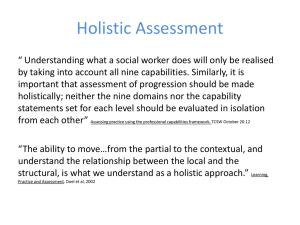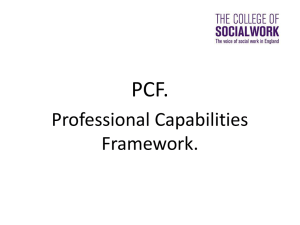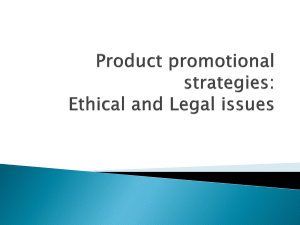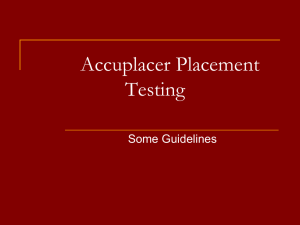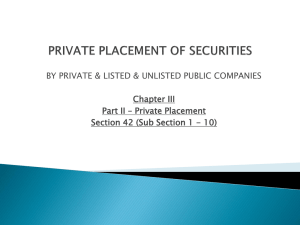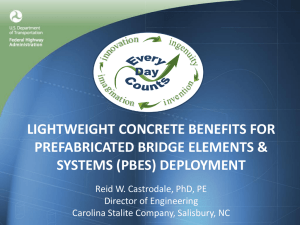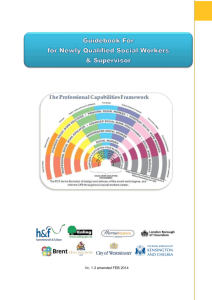PCF_Holistic Asst_HB_NOPT_July2013
advertisement
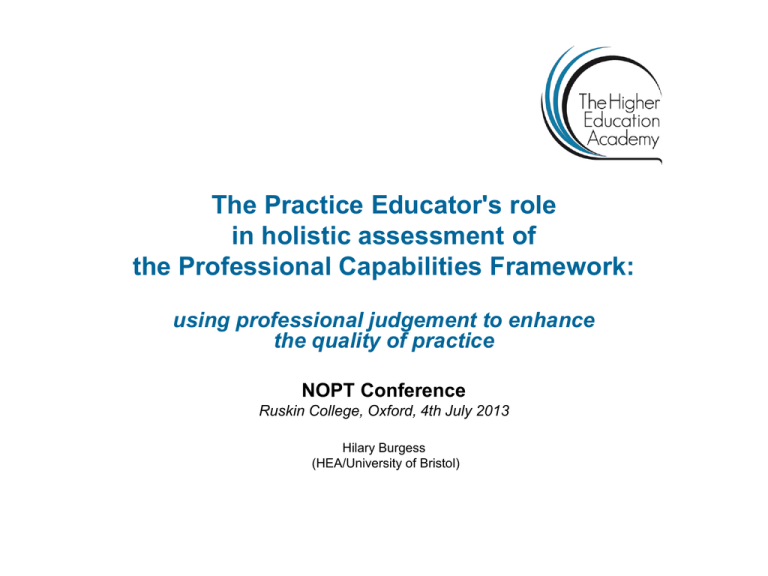
The Practice Educator's role in holistic assessment of the Professional Capabilities Framework: using professional judgement to enhance the quality of practice NOPT Conference Ruskin College, Oxford, 4th July 2013 Hilary Burgess (HEA/University of Bristol) What we will cover today • • • • The nature and purpose of the PCF The PCF in qualifying SW Education The PCF in practice placements Holistic assessment and TCSW/HEA guidance • What’s new for all parties • Some challenges Purpose of the PCF The PCF ‘sets out the profession’s expectations of what a social worker should be able to do at each stage of their career and professional development’. Professional Capabilities Framework for Social Workers The Nine Domains 1. 2. 3. 4. 5. 6. 7. 8. 9. Professionalism. Values and Ethics. Diversity. Rights, Justice and Economic Well-being. Knowledge. Critical Reflection and Analysis. Intervention and Skills. Contexts and Organisations. Professional Leadership. The nine levels 1. 2. 3. 4. 5. 6. 7. 8. 9. Entry to SW qualifying programmes. Assessed readiness for direct practice End of first placement End of second placement/end of progamme End of ASYE. Social Worker Experienced Social Worker Advanced Social Worker; Professional SW Educator; SW Manager Strategic SW Educator; Principal SW; Strategic SW Manager. Features of the PCF • 9 domains and 9 levels. • Domains are interdependent. • Relevant to social workers in all settings and with all user groups. • First attempt to provide a professional framework linked to career progression. • Developed by social workers for social workers, held by TCSW on behalf of profession. • Will change and develop to reflect developments in the profession. Features of the PCF (2) • Based on the notion of ‘Capability’: ‘An integration of knowledge, skills, personal qualities and understanding used appropriately and effectively – not just in familiar and highly focused specialist contexts but in response to new and changing circumstances’ • Developmental cf competences • Provides coherence to standards/requirements and expectations at all levels Progression Progression between levels is characterised by the ‘development of people’s ability to manage complexity, risk, ambiguity and increasingly autonomous decision-making across a range of situations.’ The PCF in qualifying SW education 1. 2. 3. 4. Entry ARDP End of first placement End final placement/qualification Entry (admission point) The capability statements at this level are intended to be used as a framework for selection of applicants to programmes, by academics with employers and/or practitioners, and service users and carers By the point of entry to SW qualifying programmes, prospective students/candidates should demonstrate awareness of social context for social work practice, awareness of self, ability to develop rapport, and the potential to develop relevant knowledge, skills and values through professional training. Assessment of Readiness for Direct Practice The statements at this level should be used as a framework to assess students’ readiness to go out on placement. By this point students should demonstrate basic communication skills, ability to engage with users, capacity to work as a member of an organisation, willingness to learn from feedback and supervision, and demonstrate basic social work values, knowledge and skills in order to be able to make effective use of first practice placement. End of first placement Statements at this level to be used as a framework to assess whether students have successfully completed their first placement. By this stage students should demonstrate effective use of knowledge, skills and commitment to core values in social work in a given setting in predominantly less complex situations, with supervision and support; and the capacity to work with people and situations where there may not be simple clear-cut solutions End of last placement/ qualifying point Statements at this level are used to assess whether student has successfully completed their qualification. By this stage students should have demonstrated the knowledge, skills and values to work with a range of user groups, the ability to undertake a range of tasks at a foundation level and the capacity to work with more complex situations. They must be able to work more autonomously; whilst recognising that the final decision will still rest with their supervisor, they will seek appropriate support and supervision. These capabilities will have been demonstrated through the last placement together with other work on the qualifying programme. So what’s new? • Practice learning progression linked into continuing professional development • First and last placements clearly identified nationally in terms of staged learning • Linked to uniform model of (30) + 70 + 100 day placement • Capability not competence • National guidance on assessment for practice learning using holistic approach Other contextual changes – Practice Educator Professional Standards – ASYE – Supervision guidelines – ‘Health checks’ and Employers Standards BUT – Cuts to budgets/staffing/’austerity’ – Mounting caseloads – Mounting needs Also Health and Care Professions Council (HCPC) Standards of Proficiency for Social Workers SoPs mapped against the PCF at qualifying level at https://www.tcsw.org.uk/standard-2col-rhm.aspx?id=6442451337 PCF qualifying level mapped against the SoPS at http://www.hpcuk.org/assets/documents/10003B0BMappingoftheHPC'sstandardsof proficiencyforsocialworkersinEnglandagainstthePCF.pdf What is holistic assessment? • Reflects the complexity (non-linearity) of SW practice: and the interplay of knowledge, skills and values, within changing contexts • All nine domains of the PCF have to be taken into account to assess a student’s capability, rather than looking at each separately. • Similarly, assessment within each domain is undertaken by looking across the elements. What is holistic assessment? (2) • Holistic assessment is ‘progressive’ (leading to a final decision) – cf ‘formative’ or ‘summative’ assessment. In progressive assessment everything that takes places counts towards the assessment decision. • Each stage should build on the previous one, with links between the ARDP, first placement and last placement, into the ASYE What is holistic assessment? (3) • ‘To understand and undertake a holistic approach to assessment, the partial and the contextual must be considered together. In this way, we arrive at a synthesis of specific and general, discrete and dynamic. This is a truly holistic approach to assessment.' (Doel et al, 1992) • Where learning or performance objectives are complex ‘the judgment of the assessor is considered central in making a holistic decision about the quality of performance,’ and ‘Understanding the whole in the light of the parts’ (Biggs, 2007) • Previous interpretation of the NOS tended to suggest and reinforce a segmented or ‘partial’ approach (‘tickbox’) What is holistic assessment? (4) • Thus practice educators need to exercise judgment, yet also pay attention to detail where necessary • Analogies – Assessing a meal – Assessing architectural submissions or PhD’s – Assessing individuals and families as a SW TCSW/HEA Guidance on holistic assessment for practice learning • Developed with PEs and academics from across England • Recommended templates in which PE records their judgement of student's capability overall, then in each of the nine domains • Supporting evidence from: DOPs, critical reflections of practice, feedback from service users & carers, evidence from supervision, agency records, student’s work, other (ideally all linked to the PCF) • A robust but concise portfolio HEA/TCSW Guidance (2) • The student comments on the report • The tutor comments on the report • The report is submitted with a recommendation to the PAP or similar • Guidance emphasises significance of placement support structures (tutor; PAP and/or other intervention measures) to clarify how problems in the placement will be resolved • Importance of interim review • Importance of clear and transparent decisionmaking process and appeals Planning for placement Information, Student access needs, CRB checks Practice Placement Cycle Placement Agreement (including learning needs of student) – completed prior to or at the start of the placement Induction Early Termination of placement with subsequent options e.g. New placement, termination of studies PRACTICE ON PLACEMENT Student generated evidence Practice Educator generated or directed evidence Evidence linked to PCF Practice Evidence SUPERVISION SESSIONS Capabilities Progress Continue cycle of positive learning No Concerns re; progress Student or Tutor concerns about placement Practice Educator ongoing assessment with evidence to support Interim review, normally with tutor visit Final Assessment Recommend: Pass/Fail/Defer Learning needs for next stage identified Student response to assessment Final Recommendation to : Practice Assessment Panel or Exam Board for final decision Practice Educator Concerns re; progress Support to Practice Educator from partnership- e.g. Early intervention, second opinion, tutor report What is new for Practice Educators? • The PE’s judgment is central, and forms the basis of the recommendation to the PAP or Exam Board (as opposed to the onus being primarily on student to selfevidence and the PE to verify) • So PE has more control/power/autonomy • Writing a holistic assessment may be new and require a different approach Links to the ASYE • General congruence of TCSW/HEA guidance with that for ASYE assessment • Some PEs will be using this already What is new for Students? • ‘A focus on practice, not writing about practice’ • They need to understand the criteria from the relevant level of the PCF, and refer to this in their discussion of practice, whilst not seeking to evidence every single part • Need to be aware of progressive (continual) assessment • Need to flag up any concerns (about the placement setting or the PE early) • Incoming students – they will not be aware of a change! What is new for Academics? • Need to be aware of and intervene if there are problematic dynamics between the student and PE • Need to support PEs generally to be confident about their own judgements (e.g. workshops) • Need to support the PE view, unless there is strong evidence to suggest this is flawed or unfair • Need to ensure consistently/QA of PE’s Working with HEIs and within regions • HEIs encouraged to work with PE’s and workforce development teams to build awareness of the PCF and of holisitic assessment • HEIs encouraged to develop regional collaboration for PL arrangements e.g. Pan London, E.Midlands etc, so that PEs are working to similar expectations Some challenges • Changing the culture of practice education: from tick-box to judgement • Linking assessment of practice with other assessment work in HE • Meeting both the PCF and the HCPC SoPs • Using/adapting TCSW/HEA guidance • Local/regional coordination • Helping final year students think about their next steps: PDP/ASYE learning plans A final thought • Exercising judgment is at the core of social work practice • PE’s have a vital gate-keeping role for the profession, but a decision to defer or fail will be made with input from others • PEs have a central role in developing the NQSW’s of tomorrow, some of whom will go on to be PSW’s, Directors, Professors or even Chief Social Workers! Feedback about holistic assessment and the use of the PCF to Hilary Burgess (HEA) h.c.burgess@bristol.ac.uk Kate Johnson (TCSW) kate.johnson@tcsw.org.uk NOPT admin@nopt.org
